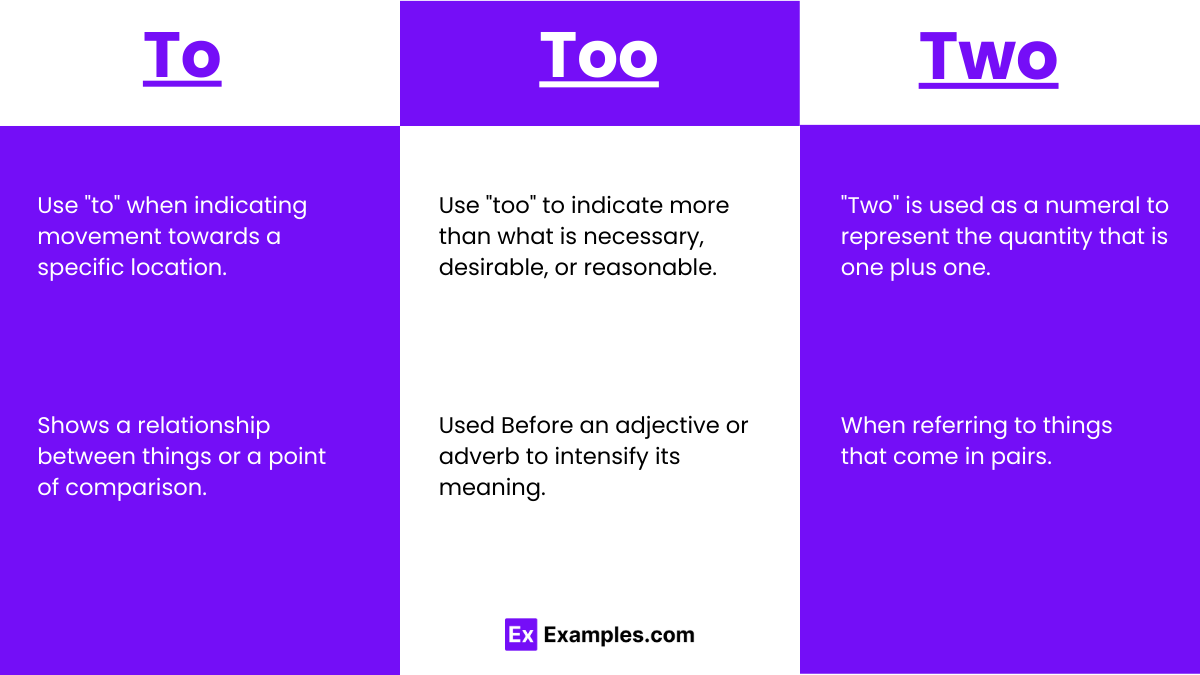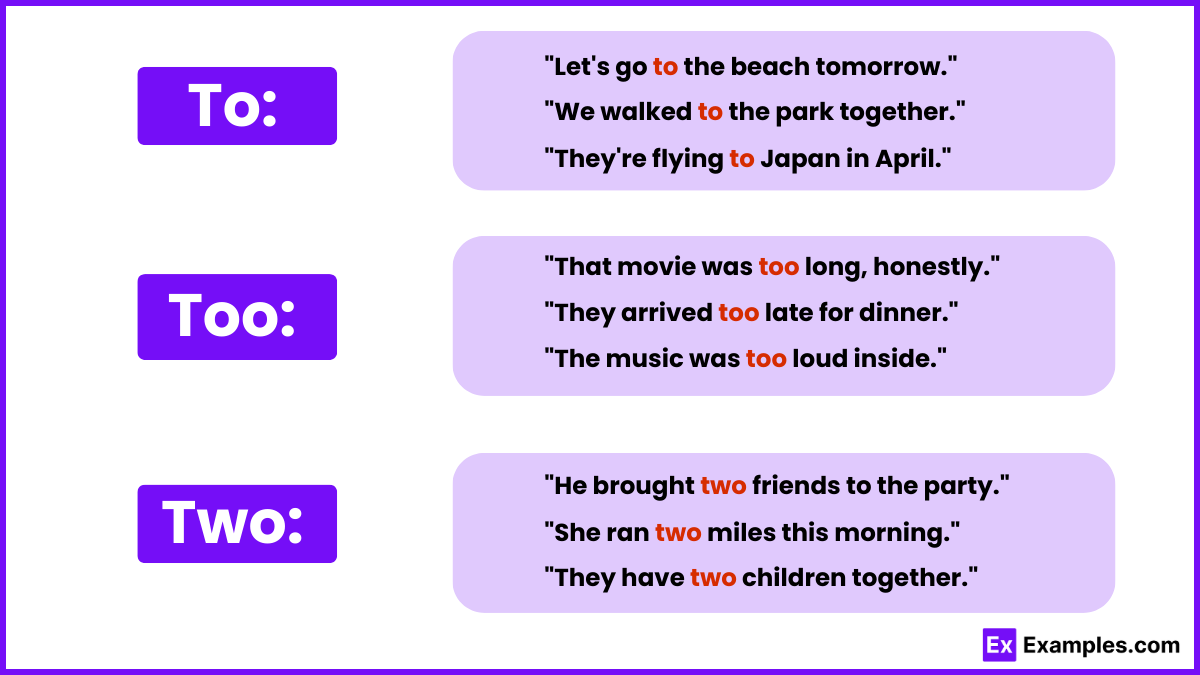To vs Too vs Two
Have you ever been chatting or writing and stopped, puzzled, over whether to use “to,” “too,” or “two“? You’re not alone! These three words sound exactly the same but mean totally different things, and mixing them up can make sentences confusing. “To” is like a helper; it shows direction, like going “to” the store, or it can link up with a verb, like “to eat.” “Too” is all about “more.” If something is “too hot,” it’s more hot than you can handle. Or, if you’re excited and say, “Me too!” you’re adding your feeling to someone else’s. “Two” is easy—it’s just the number after one. If you have “two” cookies, you’re lucky enough to have a pair to munch on.
“To,” “Too,” and “Two” – Meanings
- To: This preposition is used in expressing motion in the direction of (a particular location), approaching or reaching (a specific condition), concerning a particular relationship or matter, or in order to perform a verb. It is one of the most commonly used words in the English language, serving various grammatical functions, including indicating direction, purpose, or intention.
- Too: “Too” means more than what is desirable, permissible, or possible. It is used to indicate something in excess or in addition. It can also be used to mean “also” or “as well,” adding information that is in agreement with what has already been said.
- Two: “Two” is a number. It is the numeral that comes after one and before three. It is used to represent this quantity in writing and symbols.
Summary
How to Pronounce To, Too, and Two
- To: Pronounced as /tuː/ or /tə/ before a consonant, it has a more fluid sound that often blends into the next word, indicating movement or direction.
- Too: Also pronounced as /tuː/, but its usage in context gives it away, especially when indicating excess or agreement.
- Two: Pronounced as /tuː/, identical in sound to the others but represents the numeral 2, distinguishing it in numerical and quantitative contexts.
Differences between To, Too, and Two
| Aspect | To | Too | Two |
|---|---|---|---|
| Definition | Indicates direction, purpose, or intention. | Indicates excess or addition. | Represents the numeral 2. |
| Specificity | Used to show movement towards something or to indicate intention. | Used when something is more than necessary, or in addition to. | Used to denote the quantity of something, specifically the number after one. |
| Context | Related to action, direction, or intention. | Associated with quantities, amounts, and additional information. | Linked to counting and numeration. |
| Usage | Prepositional and infinitive marker. | Adverb describing quantity or addition. | Noun or adjective denoting number. |
| Grammatical Form | Preposition or part of the infinitive verb form. | Adverb. | Numeral. |
How to Remember the Difference between To, Too, and Two
Think of “to” as indicating direction or intention, like going “to” a place. “Too” suggests excess or addition, as in “too much” or “me too.” And “two” is simply the number, think of “two” hands or “two” eyes. These associations can help distinguish and correctly use these words.
When to Use To, Too, and Two

Usage of To
- Direction or Destination: Use “to” when indicating movement towards a specific location. Example: “I’m going to the store.”
- Infinitive Verb Form: “To” precedes the base form of a verb to form the infinitive. Example: “I love to read.”
- Receiver of Action: Indicates the person or thing that receives something. Example: “Give the book to her.”
- Indicating Relation: Shows a relationship between things or a point of comparison. Example: “This letter is important to me.”
Usage of Too
- Excessiveness: Use “too” to indicate more than what is necessary, desirable, or reasonable. Example: “This soup is too hot.”
- Also or In Addition: “Too” can mean in addition to or as well. Example: “I want some ice cream too.”
- Extremely or Very: Before an adjective or adverb to intensify its meaning. Example: “She’s too kind.”
- Informal Agreement: In informal contexts, “too” can express agreement. Example: “You think it’s funny? Me too.”
Usage of Two
- Counting and Quantifying: “Two” is used as a numeral to represent the quantity that is one plus one. Example: “I have two cats.”
- Order or Sequence: To denote a position in a list or order. Example: “She finished in two hours.”
- Pairing or Coupling: When referring to things that come in pairs. Example: “Two heads are better than one.”
- Describing Duplicates: When there are two identical items or concepts. Example: “I bought two identical shirts.”
How to Use To, Too, and Two
Using To
- Preposition: As a preposition, “to” links nouns, pronouns, or phrases to other words within a sentence. “They walked to the park.”
- Infinitive Verb Form: “To” is used with the base form of a verb to express purpose, intention, or future action. “To understand is to forgive.”
Using Too
As an Adverb: “Too” modifies verbs, adjectives, and other adverbs to indicate excessiveness or addition. “The soup is too hot to eat.”
Using Two
As a Numeral: “Two” is used to indicate the number of items, people, or the order in something. “She has two brothers.”
To, Too, and Two – Examples

To – Examples
- “We walked to the park despite the cold.”
- “I need to finish my homework before I can go out.”
- “They’re going to start the meeting without us if we don’t hurry.”
- “She handed the letter to him quietly.”
- “He’s learning to play the piano.”
Examples of Too
- “It’s too early to make any decisions.”
- “This box is too heavy for me to lift alone.”
- “I think that movie was too long.”
- “Can I come along too?”
- “He ate too much cake at the party.”
Two – Examples
- “The twins were inseparable, always doing everything in two.”
- “She waited two hours before finally leaving.”
- “The recipe called for two teaspoons of sugar.”
- “They saw two movies back-to-back at the cinema.”
- “Two heads are better than one, they say.”
Synonyms
| Term | Synonyms |
|---|---|
| To | Towards, for |
| Too | Excessively, also, additionally |
| Two | Pair, duo |
Exercise
Fill in the blanks with either “to,” “too,” or “two” to complete the sentences accurately.
- I need to go ___ the grocery store.
- She added ___ much salt to the recipe.
- They have ___ children.
- I would like ___ come along as well.
- He is going ___ be the keynote speaker.
Answers
- to
- too
- two
- too
- to
FAQ’S
What is the difference between too, two, and to?
“To” indicates direction, “too” means excessively, and “two” is the number after one.
What is the difference between too much and to?
“Too much” signifies excess, while “to” is used for expressing direction or purpose.
What is the difference between too and T?
“Too” implies excessiveness; “T” is the 20th letter of the alphabet.
How do you remember the difference between to, too,
and two?
Remember: “to” for direction, “too” for excess, and “two” for the number.
What is the rule for too, to, two?
Use “to” for direction, “too” for excess, and “two” as the numeral.


